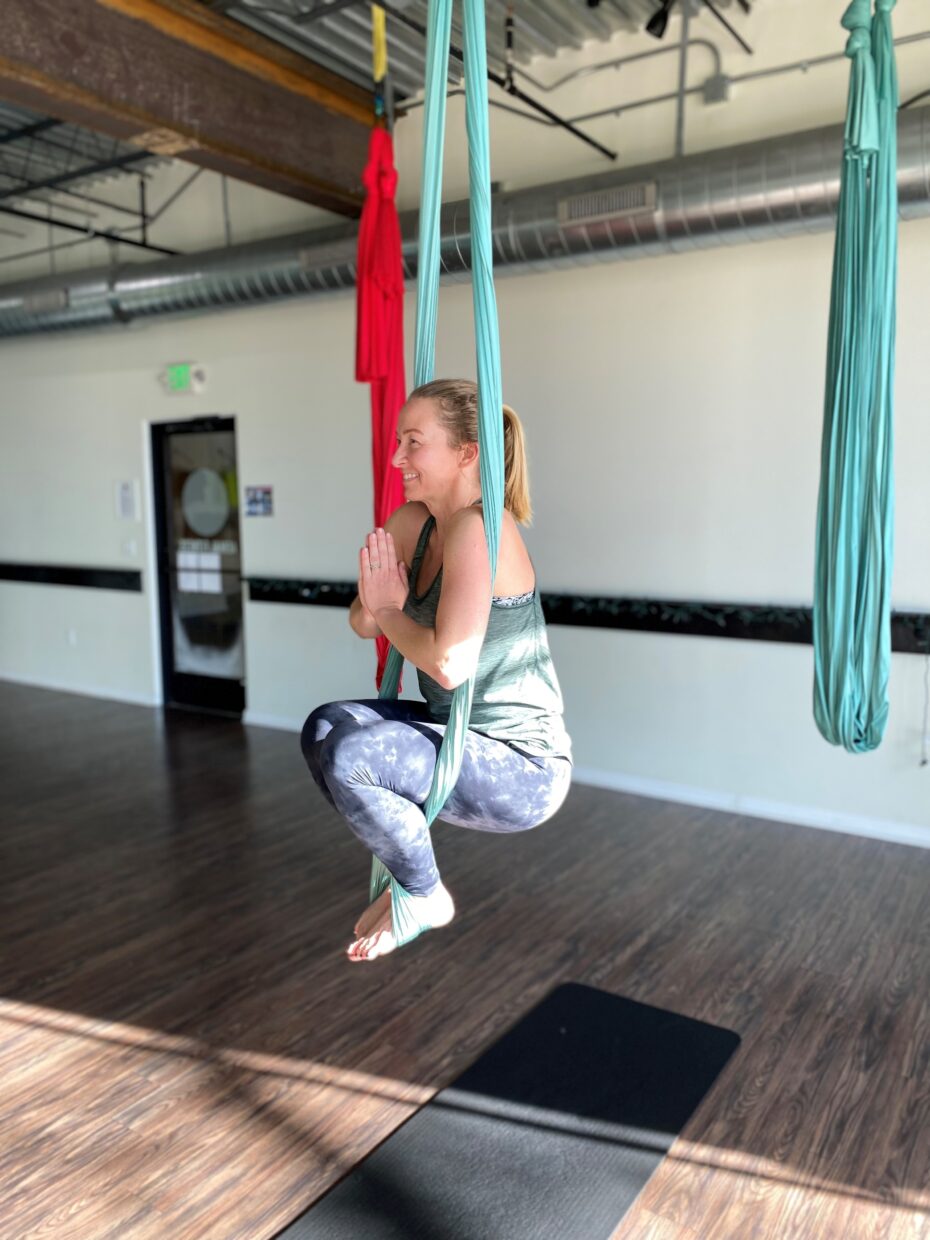From the Winter 2022 Journal of the Colorado Dental Association
Often when we take care of others, we bear the extra weight—both figuratively and literally. Taking a day or even a week off is a great start to make time for self-care, but after that break it doesn’t take long to fall right back into the same routine we needed a break from in the first place. As dental providers, caring for others is part of the job; but it’s important to care for the caregiver too.
In Q1 this year, the CDA is focusing on physical wellness. But how do we make time for activity and, more importantly, how do we make this a habit and not a month-long resolution?
We asked some of the experts. Read about what your colleagues do to make their physical wellness a lifestyle.
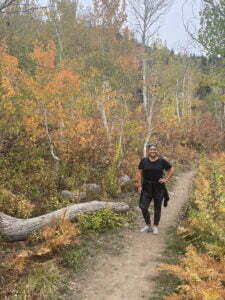
Dr. Khalsa enjoying a pain-free weekend in Steamboat Springs last fall.
Dr. Sati Khalsa
I quickly learned in dental school that clinical dentistry is fun, challenging, incredibly rewarding and can really hurt your back, neck, forearms and hands. But I didn’t pay attention to ergonomics, and I didn’t listen when my faculty would tell me to sit up straight. The more I concentrated on a procedure, the lower my body would bend. I would regularly compromise my working position for the comfort of patients. I wasn’t trained in dental loupes. By the time I graduated in 2006 my trapezius and scalene muscles were regularly on fire. I let myself work for years with poor habits and would pay for it in regular periods of acute pain that would affect being able to enjoy life. The acute pain turned to chronic pain, and I had resigned to the idea that this is my work, and this is how it was going to be. It is only in hindsight and the major scare of an unrelenting muscle episode in early 2020 that I finally recognized and admitted that I was doing it all wrong. In fact, the pandemic lockdown of 2020 allowed me time to re-focus and put in some real effort and energy to learn and actually practice what my body needs to achieve a level of physical wellness.
After 14 years into my dental career, my priorities are finally adjusted to taking care of my neck and back to allow me to be a better provider. When you have experienced the fear of chronic pain it affects every minute of your existence, every activity and everyone around you. I have now had more pain-free weeks and months in the past year and a half than I have had in the past 12 years. Pain is quickly a reminder to not slouch in the couch when I’m watching TV or sitting at the computer. I use supportive sleeping pillows to ensure that I’m sleeping aligned and in neutral positions. My acupuncturist can stop a triggered muscle spasm in its tracks. Dynamic massage therapy and cupping helps stretch and release muscle tension and relieves pressure on my nerves. On my own I work hard to continue daily targeted physical therapy stretches and exercises. Heat therapy every morning, evening and whenever I start to feel the tension creep up. I know my story is not unique; I know everyone in the dental field has experienced some level of this. I want to remind others to be mindful of their working positions, their rest positions, to try dental loupes, to take a moment to stretch between patients and to prioritize self-care even when it’s hard. Keeping my body and muscles loose is a full-time job that allows me to keep up the work I love and the lifestyle I want.
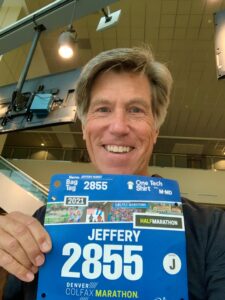
Dr. Hurst at the Denver Colfax Half Marathon.
Dr. Jeff Hurst
As a practicing dentist of over 40 years, I want to be the one who determines when I’m going to retire. I have chosen to never let age determine when and if I can pursue an activity. Age is just a number that can be used to motivate or to procrastinate.
I stay active and in shape for two main reasons: I want to be healthy to continue to treat my patients and I want to be able to do the activities that I am enjoying now along with those I intend to do in the future. It’s so easy to say, “I’m tired” or “I’ll do it tomorrow,” but it’s just as easy to make a commitment to adopt a lifestyle that puts you first.
I have always tried to be in good shape but in 2012, my life changed when my daughter asked me to run a half marathon with her. I ran my first one in Disneyland and have continued to run in them every year since, and I plan on doing this for many years to come. Although running is my main passion, I enjoy biking, hiking and skiing. When I’m inside, I have a series of home exercises that involve free weights, cardio and PIYO. We can all make time in our days for ourselves. I try to stick to a routine and my patients know it. There have been several occasions where they have seen me running and enjoying the outdoors.
I have integrated my feelings and actions on wellbeing into my practice and the patients we serve. My practice focuses on looking at the patient’s total health—not just their teeth. While doing their exams, a lot of my patients know about my active lifestyle and will ask for my advice on nutrition and exercise, and how it will relate to their wellbeing and dental health. I tell many of them they don’t need a gym membership or a personal trainer. Just put down your fork and pick up your feet. A 30-minute walk is an easy way to start on your road to good health. You don’t stop running because you get old, you get old because you stop running.
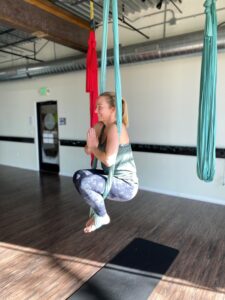
Dr. Compton taking an aerial yoga class.
Dr. Lindsay Compton
Last fall I had to find a new way of working out and moving. My routine and go-to workouts became mundane and not exciting. I was in a rut and needed to find new motivations to exercise. I spent more energy looking for excuses to not workout than the actual workout itself. I found myself giving in to pressure and stress without an outlet. Once I found one excuse to not workout, it multiplied, and I soon had an excuse to not workout every day. I rationalized that it was a good trade off because I had extra time and thought I could accomplish more. Unfortunately, my productivity went down and so didn’t my energy levels. Now that I didn’t have energy, I couldn’t possibly fathom mustering enough energy for a short jog.
Before COVID, I was an avid runner finishing three marathons, a dozen half marathons, and too many 10Ks and 5Ks to count. I lifted weights twice a week and felt strong. I’ve climbed 20 14ers and can honestly admit I loved every one of them. In previous winters, I would ski 20 days on my pass and even took up cross country skiing. I would snowshoe when I didn’t want to battle the lift lines. Once the gyms closed, race sign-ups stopped, and I had to make a reservation to ski. I found all my excuses and lost all my motivation. I became submerged in Zoom meetings and worrying about my business. I poured over details and emails in any free time I had. My quality of sleep was horrible. I ate absolute junk because I didn’t have to think about how the food I was eating would properly fuel a workout.
A turning point finally came last fall. I was just tired of feeling tired. I was tired of not feeling accomplished. I was tired of feeling weak. I knew what I had to do and I had to commit. I had to feel accountable to myself and I had to outsmart myself. I had to outsmart all my dumb and non-valid excuses. I had to “out excuse” myself. I had to be better. The best way I found to out excuse myself was to find variety. I had to break up the mundane and leave my comfort zone. I learned about some apps that I could use to find workout classes in my area. Two examples are MindBody and ClassPass (ClassPass is even an ADA member benefit). I knew that if I started going to classes, I would find my competitive nature. I would want to excel at these classes and the only way I could do that is be active outside of the class. This is where I tricked myself. And it worked!
I’m back to running every morning and taking a different class every week. My sleep is deep and restful. My brain fog has lifted and I’m a much more present boss and dentist. I have more energy than I’ve had in a year, and I make room in my schedule to move and be active without excuses. I appreciate my workout change and remember the value of staying active.
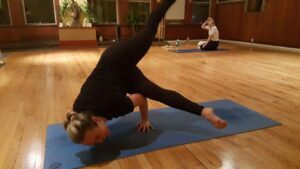
Dr. Worthington making time for fun in her favorite yoga studio.
Dr. Evin Worthington
Dentistry is a challenging occupation, both mentally and physically. We all know that in the absence of self-care, our health can deteriorate quite quickly. Many of our colleagues have different ways to address this, whether it be through exercise, meditation, or just an awesome happy hour. What I’d like to share is one thing that I have incorporated into my daily life that has greatly helped keep me healthy, both physically and mentally.
The practice of yoga has roots in India, dating back some 5,000 years ago. While there are many different forms and what seems like thousands of studios in Denver to choose from, it is important for each individual to find a studio and style that is most fulfilling to what they need. Personally, I have found that a solid vinyasa class at a well-established studio has contributed immensely to my practice. It has also helped me form meaningful relationships with my yoga family, adding to the mental wellbeing aspect of yoga.
First, there is the physical side of yoga. The practice of yoga incorporates stretching, movement through breathing, balancing, and can advance into strength training exercises. Heated yoga adds another element to yoga by providing the added challenge of staying focused on the exercise at hand while sweating buckets, all the while providing a great detoxifying experience. There are studios like CorePower that offer sculpting classes, which incorporate free weights into the practice, making for a more aerobic style of yoga. Yin yoga, by contrast, focuses completely on the student moving into a shape, usually in a seated or flat position, and staying in that form while breathing deeply for up to 4 minutes. This gives the student the experience of a massive muscle release and intense stretch not otherwise achieved in other classes. No matter the style, there is a class that can provide a different element for any yogi, depending on what is necessary for that particular day. Because dentistry wears on the body so much, I have found that yoga can be incredibly restorative, and has provided me with an incredible amount of physical relief after a long day of back-breaking work.
The other element of yoga is less tangible but just as important, Yoga is the practice of movement through meditation. All movements are done to a series of steady, deep in-and-out breaths, and one of the major purposes of yoga is to close off the outside world, and to focus on what is happening in the present moment. What I have found through my practice is that no matter what has happened to me that day, no matter how challenging my day has been, when I finish my yoga class and leave my mat, I no longer have any negative or stressful emotions left. Instead, I only have a sense of calm—something I have never been able to achieve in any other forms of exercise I have tried. This aspect of yoga, more than anything, is the number one reason why I continue to return to my mat time and time again.
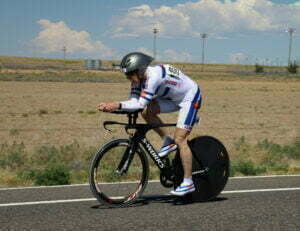
Dr. Van Zytveld competing in a time trail at the National Senior Games.
Dr. Eric Van Zytveld
I was fortunate to discover the mental and physical benefits of regular exercise in my early 20s. A couple of years after a lower back injury at age 19, I learned regular strengthening and stretching exercises were crucial in maintaining a relatively pain free back. Avid bicycle riding when the weather allowed and swimming all year-long helped achieve that goal. I remember enjoying a late winter’s bicycle ride about 35 years ago and then asking myself, why don’t I ride all winter? Considering Denver’s weather is very conducive to riding year-round, I decided to reap the benefits of bicycle commuting.
From that point on I have commuted by bicycle as much as possible. By bicycle commuting I am able to build exercise into my day while minimizing the time away from my family. I avoid rationalizing why I don’t feel like exercising. Exercising before and after work is a tremendous way to destress emotionally. I ride about 300 days per year with a goal of riding 6,000 miles each year. Unless the bike trail is icy or the temperatures frigid, I can comfortably ride. When the conditions are too inclement, I am fortunate to have access to light rail which gives me a three-to-four-mile walk each day instead. Often on my commute home I feel my emotional stress level decrease as I focus on the world around me. Amazingly, most days I feel less tired when I get home than I did when I left work.
Although I am not a very competitive person, in my early 50s I began riding a time trial bike in the National Senior Games. A few years ago, I added power walking to my routine. The goal of competing and qualifying motivates me to work harder and more consistently than I would otherwise. The events are also great fun and build tremendous friendships.
Another daily work ritual is a 20-to-25-minute walk during lunch. It allows me to reboot after a morning treating patients. It clears my mind and helps me stretch out stiff muscles from sitting chairside. I’ve made two other changes while practicing dentistry that have improved my ergonomics tremendously. The first is the surgical microscope I use for almost all intraoral procedures. It affords a more relaxed head and neck posture. The second is standing while performing exams and during some procedures, which reduces the lower back strain that results from sitting.
My daily routine ends with strengthening exercises followed by 20-30 minutes of stretching, which helps me relax mentally and physically. Developing my physical wellness definitely has added years to my enjoying the practice of dentistry.
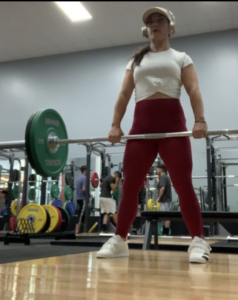
Elise doing what she loves, weightlifting at the gym.
Elise Ambrose, DS2
I am currently a second-year dental student, but I am also a weightlifter. I have been interested in this hobby since I was young and watched my father lift. This inspired me to partake in this hobby and start my own endeavor in the sport. I always admired the confidence and physical strength of weightlifters, and I wanted to replicate this in myself.
I have been weightlifting consistently for the past six years and it has become part of my personality. This was despite my newest adventure of dental school. With a highly demanding schedule, I had to manipulate my time in a way where I could have the best of both worlds. I took pride in my physical strength, which kept me motivated to continue working out. I knew it was vital to keep this hobby going, because when I didn’t lift, my overall moral and memory faltered. When I didn’t lift, my mental stamina was affected, as well as my lab work performance and test scores. I even experimented to see if I focused only on dental school and ignored my lifting if I would increase performance in school. I learned that when I didn’t feel well and failed to separate myself from my studies, I would get discouraged and wouldn’t do as well. Weightlifting is my stress release, and my confidence increases when I work on my health alongside my studies. Dental school and weightlifting complement each other perfectly for me.
When self-evaluating success, I always felt it was multifactorial. If I wanted to succeed in my education and career, I had to remain driven when I felt like giving up and become stronger every day. My hobby of weightlifting embodies just that—you must remain driven to see results, disciplined to fight through the feeling of giving up, and become stronger with consistency. Whenever I felt tired from the new information I was learning, I would think back to my hobby. If I want to succeed at becoming a great dentist, I would have to work hard every day to become stronger in hand skills and obtaining knowledge. This motivates and inspires me daily to continue with my hobbies and balance my health with my education.

